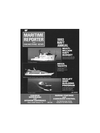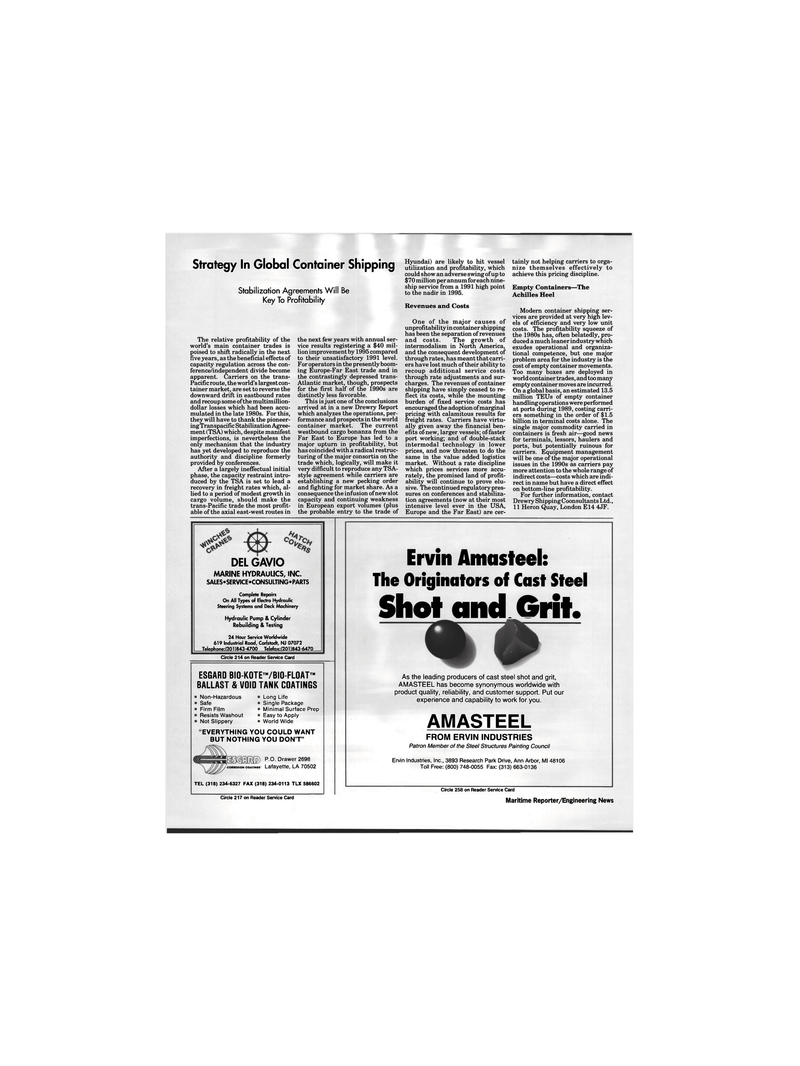
Page 74: of Maritime Reporter Magazine (February 1992)
Read this page in Pdf, Flash or Html5 edition of February 1992 Maritime Reporter Magazine
Strategy In Global Container Shipping
Stabilization Agreements Will Be
Key To Profitability
The relative profitability of the world's main container trades is poised to shift radically in the next five years, as the beneficial effects of capacity regulation across the con- ference/independent divide become apparent. Carriers on the trans-
Pacific route, the world's largest con- tainer market, are set to reverse the downward drift in eastbound rates and recoup some of the multimillion- dollar losses which had been accu- mulated in the late 1980s. For this, they will have to thank the pioneer- ing Transpacific Stabilization Agree- ment (TSA) which, despite manifest imperfections, is nevertheless the only mechanism that the industry has yet developed to reproduce the authority and discipline formerly provided by conferences.
After a largely ineffectual initial phase, the capacity restraint intro- duced by the TSA is set to lead a recovery in freight rates which, al- lied to a period of modest growth in cargo volume, should make the trans-Pacific trade the most profit- able of the axial east-west routes in the next few years with annual ser- vice results registering a $40 mil- lion improvement by 1995 compared to their unsatisfactory 1991 level.
For operators in the presently boom- ing Europe-Far East trade and in the contrastingly depressed trans-
Atlantic market, though, prospects for the first half of the 1990s are distinctly less favorable.
This is just one of the conclusions arrived at in a new Drewry Report which analyzes the operations, per- formance and prospects in the world container market. The current westbound cargo bonanza from the
Far East to Europe has led to a major upturn in profitability, but has coincided with a radical restruc- turing of the major consortia on the trade which, logically, will make it very difficult to reproduce any TSA- style agreement while carriers are establishing a new pecking order and fighting for market share. As a consequence the infusion of new slot capacity and continuing weakness in European export volumes (plus the probable entry to the trade of
Hyundai) are likely to hit vessel utilization and profitability, which could show an adverse swing of up to $70 million per annum for each nine- ship service from a 1991 high point to the nadir in 1995.
Revenues and Costs
One of the major causes of unprofitability in container shipping has been the separation of revenues and costs. The growth of intermodalism in North America, and the consequent development of through rates, has meant that carri- ers have lost much of their ability to recoup additional service costs through rate adjustments and sur- charges. The revenues of container shipping have simply ceased to re- flect its costs, while the mounting burden of fixed service costs has encouraged the adoption of marginal pricing with calamitous results for freight rates. Carriers have virtu- ally given away the financial ben- efits of new, larger vessels; of faster port working; and of double-stack intermodal technology in lower prices, and now threaten to do the same in the value added logistics market. Without a rate discipline which prices services more accu- rately, the promised land of profit- ability will continue to prove elu- sive. The continued regulatory pres- sures on conferences and stabiliza- tion agreements (now at their most intensive level ever in the USA,
Europe and the Far East) are cer- tainly not helping carriers to orga- nize themselves effectively to achieve this pricing discipline.
Empty Containers—The
Achilles Heel
Modern container shipping ser- vices are provided at very high lev- els of efficiency and very low unit costs. The profitability squeeze of the 1980s has, often belatedly, pro- duced a much leaner industry which exudes operational and organiza- tional competence, but one major problem area for the industry is the cost of empty container movements.
Too many boxes are deployed in world container trades, and too many empty container moves are incurred.
On a global basis, an estimated 13.5 million TEUs of empty container handling operations were performed at ports during 1989, costing carri- ers something in the order of $1.5 billion in terminal costs alone. The single major commodity carried in containers is fresh air—good news for terminals, lessors, haulers and ports, but potentially ruinous for carriers. Equipment management will be one of the major operational issues in the 1990s as carriers pay more attention to the whole range of indirect costs—costs which are indi- rect in name but have a direct effect on bottom-line profitability.
For further information, contact
Drewry Shipping Coonsultants Ltd., 11 Heron Quay, London E14 4JF.
DEL GAVIO
MARINE HYDRAULICS, INC.
SALES*SERVICE*CONSULTING*PARTS
Complete Repairs
On All Types of Electro Hydraulic
Steering Systems and Deck Machinery
Hydraulic Pump & Cylinder
Rebuilding & Testing 24 Hour Service Worldwide 619 Industrial Road, Carlstadt, NJ 07072
Telephone:l2011843-4700 Telefax:(201)843-6470
Circle 214 on Reader Service Card
ESGARD BI0-K0TE™/BI0-FL0AT™
BALLAST & VOID TANK COATINGS
Non-Hazardous
Safe
Firm Film
Resists Washout
Not Slippery
Long Life
Single Package
Minimal Surface Prep
Easy to Apply
World Wide
EVERYTHING YOU COULD WANT
BUT NOTHING YOU DON'T"
P.O. Drawer 2698 corrosion coatings Lafayette, LA 70502
TEL (318) 234-6327 FAX (318) 234-0113 TLX 586602
Ervin Amasteel:
The Originators of Cast Steel
Shot and Grit.
As the leading producers of cast steel shot and grit,
AMASTEEL has become synonymous worldwide with product quality, reliability, and customer support. Put our experience and capability to work for you.
AMASTEEL
FROM ERVIN INDUSTRIES
Patron Member of the Steel Structures Painting Council
Ervin Industries, Inc., 3893 Research Park Drive, Ann Arbor, Ml 48106
Toll Free: (800) 748-0055 Fax: (313) 663-0136
Circle 258 on Reader Service Card
Circle 217 on Reader Service Card Maritime Reporter/Engineering News

 73
73

 75
75
